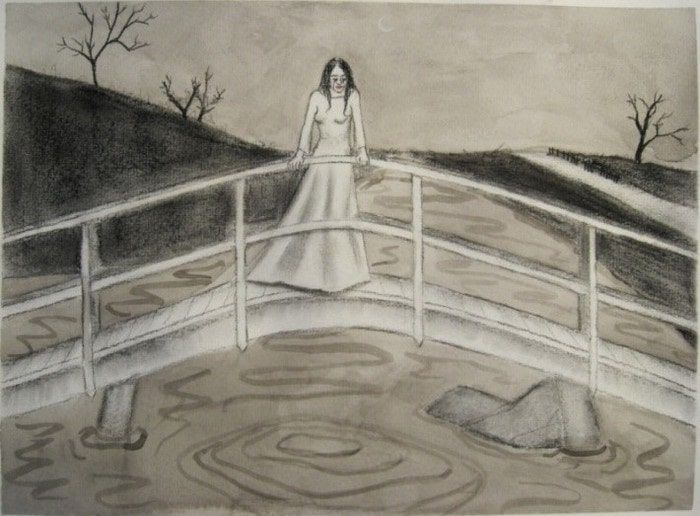La Llorona, a pre-Hispanic legend with its infamous evil spirits
La Llorona is associated with the famous adverse omens that happened before the Conquest and predicted the end of the Mexica empire of Tenochtitlan.

The well-known story of "La Llorona" has its origin in the pre-Hispanic world. It is associated with the famous adverse omens that supposedly happened before the Spanish Conquest and predicted the end of the Mexica Empire of Tenochtitlan.
She transcended the colonial world and the story of that woman who appears and groans for her children still endures today. A woman dressed in white and black hair walks the streets at night, mourning, crying, and begging for the loss of her children.
During the time of the colony in the streets of New Spain, at night you could hear the lamentations of a woman that we now know as "La Llorona".
"My children, beloved sons of Anahuac, your destruction is near as you went away toward the hills that covered the skirts of the near mountains, continued to groan and sob: Where will you go, where can I take you to escape from such fatal destiny? My children, you are about to get lost".
Mexican Legend of the Viceroyalty Period
Once the conquest was completed and more or less in the middle of the 16th century, the residents of Mexico City who gathered in their homes at curfew time, ringing the bells of the first Cathedral; at midnight and mainly when there was a moon, they woke up frightened when they heard in the street, sad and very long moans, launched by a woman who was undoubtedly afflicted by deep moral pain or tremendous physical pain.
The first nights, the neighbors were content with their persignation or sanctification, and according to them those dismal moans were of the soul of the other world; but they were so many and repeated, and lasted so long, that some daring and carefree people wanted to ascertain with their own eyes what it was; And first from the ajar doors, from the windows or balconies, and at once daring to go out by the streets, they were able to see the one who, in the silence of the nights or in those in which the pale and transparent light of the moon fell like a vaporous mantle on the high towers, roofs and ceilings, and streets, launched sharp and very sad moans.
The woman wore a very white suit, and a thick white veil covered her face. With slow and quiet steps she walked through many streets of the sleeping city, every night different, although not missing a single one, to the Plaza Mayor, where her veiled face turned to the east, kneeling, she gave her last anguished and languid lament; standing up, she continued with her slow and paused step toward the same direction, when she reached the shores of the brackish lake, which at that time penetrated some neighborhoods, as a shadow vanished.
The advanced hour of the night, the silence and loneliness of streets and squares, the costume, the air, the slow walk of that mysterious woman and, above all, the penetrating, acute and prolonged moaning of her, which was always falling on the ground on her knees, She formed a group that terrified all those who saw and heard her, and not few of the brave and strong conquerors, who had been afraid of the same death, remained in the presence of that woman, mute, pale and cold as if she were made of marble.
The most courageous barely dared to follow her at a long distance, taking advantage of the moon's clarity, with nothing else to do but watch her disappear when she reached the lake as if she were submerged in the waters, and being unable to find out more about her, and ignoring who she was, where she came from and where she was going, she was given the name of La Llorona.
Such is, in a few words, the genuine popular tradition that for more than three centuries remained engraved in the memory of the inhabitants of Mexico City and has been erased as the simplicity of our customs and the candor of Mexican women have been lost.
But forgotten or almost disappeared, the story of La Llorona is very old and it became generalized in many places of our country, transformed or associated to passionate crimes, and that wandering and white shadow of a woman, seemed to enjoy the gift of ubiquity because she was walking on roads. It penetrated the villages, towns, and cities, sank into the waters of lakes, waded through rivers, climbed to the tops where there were crosses, to cry at the foot of them, or faded away when entering the caves or approaching the walls of a cemetery.
The tradition of La Llorona has its roots in the mythology of the ancient Mexicans. Sahagún in his History (book 1, Chapter IV), speaks of the goddess Cihuacoatl, who "appeared many times as a lady composed with some attire as used in the Palace; they also said that at night she would shout and roar in the air... The attire with which this woman appeared was white, and the hair touched them in such a way that she had like crossed ergot on her forehead.
The same Sahagún (Lib. XI), refers that among many auguries or signs with which the Conquest of the Spaniards was announced, the sixth prognosis was "that at night voices would be heard many times as of a woman who in anguish and with tears said: "Oh, my children, where will I take you so that you do not get lost?
The tradition is, therefore, very remote persisted at the arrival of the Castilian conquerors and taken the Aztec city by them and dead years later Dona Marina, or the Malinche, told that this was La Llorona, which came to punish the other world for having betrayed the indigenous race, helping foreigners to subdue them.
Sometimes La Llorona was a young woman in love, who had died on the eve of her wedding and brought to the groom a crown of white roses that she did not wear; other times she was the widow who saw her tender orphans crying; and the wife who died in the absence of her husband, to whom she came to bring the farewell kiss that she could not give him in his agony; and the unfortunate woman, vilely murdered by her jealous spouse, who appeared to lament her unhappy end and protest her innocence.
Little by little, through the times, the old tradition of La Llorona has been erased from popular memory. The only memory left of it is in the mythological splendor of the Aztecs, in the pages of ancient chronicles, in the distant villages, or on the lips of the old grandmothers, who try to frighten their innocent grandchildren, telling them: Here comes La Llorona!
The figure of La Llorona, the protective mother who lost her children and returns each time to look for them, was integrated as one of the most narrated characters among Mexicans, who served to scare off tantrums or disobedient kids at night with the maternal threat of being carried by La Llorona.




